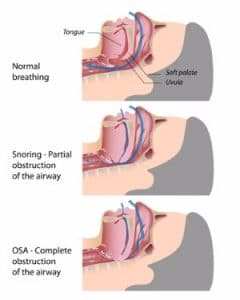We are very glad you found your way to this page about orthodontic treatment for sleep apnea. There isn’t a whole lot of awareness out there regarding sleep apnea, even though it is a dreadful life-damaging and life-shortening disease. Unbelievably, sleep apnea affects over 22 million Americans a year. That’s the number of people you can accommodate into 275 football stadiums! A staggering number, indeed.
Download Our Free Orthodontic Care Guide
So, what is sleep apnea?
Sleep apnea is a potentially serious sleep disorder in which a patient’s breathing stops and starts multiple times while they sleep. Sleep apnea also manifests itself in the form of extremely shallow breathing during sleep. These shallow breaths or the lack of breathing can last anywhere between a few seconds to several minutes. We cannot emphasize how severely damaging it is to the human body to be deprived of oxygen for several seconds, let alone minutes.
Types of Sleep Apnea
 There are three different kinds of sleep apnea.
There are three different kinds of sleep apnea.
- Obstructive Sleep Apnea (OSA): OSA can be mild (5-14 interruptions an hour), moderate (15-30 interruptions an hour) or severe (30 or more interruptions an hour).
It is the most commonly diagnosed type of sleep apnea. Studies suggest that only about 10% of people with OSA receive medical treatment. This is because most OSA sufferers are often undiagnosed. Obstructive sleep apnea occurs when part or all the airway is blocked during sleep. This may happen because the tongue rolls toward the back of the mouth or because a patient has an excess of fatty tissue that blocks the throat.
- Central Sleep Apnea (CSA): Unlike OSA, central sleep apnea isn’t caused from airways getting blocked by the tongue or other fatty tissue. Instead, central sleep apnea occurs when the brain fails to send a message to the muscles involved to keep breathing.
Why this type is particularly dangerous is because the brain is part of the central nervous symptom. During an apneic episode, the brain is no longer communicating properly with the muscles when an individual is asleep to keep them breathing normally. CSA is not as common as OSA. It is typically a side effect of a brain injury or a medical issue that affects the brain. With CSA, a common symptom is mood swings.
- Complex/Mixed Sleep Apnea: The third type of sleep apnea is complex sleep apnea. Patients diagnosed with complex sleep apnea typically have a combination of OSA and CSA. Healthcare professionals will usually diagnose complex sleep apnea after a sleep study that shows that the patient has signs of each.
Following considerable research, complex sleep apnea was defined as a condition in which patients diagnosed suffering from obstructive sleep apnea still were unable to breathe normally after their blocked airways were opened. Instead, their sleep apnea assumed the characteristics typical of central sleep apnea, where the brain failed to issue breathing commands during apneic episodes.
Signs of Sleep Apnea
 Most people who are diagnosed with sleep apnea admit to having only sought treatment after somebody else noticed breathing abnormalities while they slept. This is because the most tell-tale symptoms of sleep apnea occur while the patient is sleeping. Unless, they are recording themselves while they sleep, there is little chance of a person recognizing the classic symptoms. However, these symptoms are easy to recognize in another. Some classic observable symptoms are:
Most people who are diagnosed with sleep apnea admit to having only sought treatment after somebody else noticed breathing abnormalities while they slept. This is because the most tell-tale symptoms of sleep apnea occur while the patient is sleeping. Unless, they are recording themselves while they sleep, there is little chance of a person recognizing the classic symptoms. However, these symptoms are easy to recognize in another. Some classic observable symptoms are:
- Unusually loud snoring
- Episodes of no breathing, breathing through the mouth or loud breathing
- Choking or gasping
If you notice the above symptoms in a loved one, please be sure to have the individual tested for sleep apnea. Orthodontic treatment for sleep apnea can help them get their life back, and prevent potentially life-threatening issues.
While another person can observe the above symptoms, there are certain red flags that an individual may want to watch out for in themselves. These do not definitively imply that the person suffers from sleep apnea, but a presence of these signs must be investigated to rule out possible sleep apnea.
- You are exhausted and fatigued all day, despite having gotten plenty of sleep.
- You have trouble paying attention and keep zoning out during the day.
- You wake up suddenly feeling short of breath.
- You wake up every morning with a headache.
- You wake up with an unusually dry mouth or with a sore throat.
- You struggle to fall asleep or stay asleep (or you struggle with both).
- You are irritable.
- You wake yourself up choking or gasping.
- You suffer from hypertension that does not respond to medication.
- You experience heart palpitations for seemingly no reason.
If you observe one or more of these symptoms in yourself or a loved one, please be sure to contact a healthcare professional. Often, sleep apnea can be treated using orthodontics alone by clearing up obstructed airways. Our team of skilled orthodontists specialize in orthodontic treatment for sleep apnea. You are welcome to call our office to schedule a free screening.
How Orthodontic Treatment for Sleep Apnea Can Help
 When evaluating a patient for orthodontic treatment, we can often identify an airway obstruction issue that contributes to other problems. One rather common problem is sleep apnea. Oftentimes, we discover that a narrow upper jaw might be causing some breathing issues. This is because the upper jaw is directly connected to the nasal cavity. Orthodontic treatment can be used to increase the width of the upper jaw. In treating that upper jaw’s width problem, we effectively decrease resistance to nasal airflow. Conversely, we may also consider the horizontal relationships between the upper and lower jaws. Rendering treatments that bring jaws forward can also help to promote a bigger airway.
When evaluating a patient for orthodontic treatment, we can often identify an airway obstruction issue that contributes to other problems. One rather common problem is sleep apnea. Oftentimes, we discover that a narrow upper jaw might be causing some breathing issues. This is because the upper jaw is directly connected to the nasal cavity. Orthodontic treatment can be used to increase the width of the upper jaw. In treating that upper jaw’s width problem, we effectively decrease resistance to nasal airflow. Conversely, we may also consider the horizontal relationships between the upper and lower jaws. Rendering treatments that bring jaws forward can also help to promote a bigger airway.
When it comes to our younger patients, our approach to their treatment is typically more conservative: we try to protect the airway, rather than restrict it. These corrections are much harder to make in adult patients. If an adult patient suffers from sleep apnea, orthodontics will help them, but additional treatment may be necessary to treat the entire problem. Many of these patients will likely benefit greatly from surgical intervention that brings their jaws forward, further opening their airway.
If you or a loved one is suffering from sleep apnea, schedule a free screening. Our orthodontists will explain how we use orthodontic treatment for sleep apnea and how we can help you get your sleep back!
Download Our Free Orthodontic Care Guide

